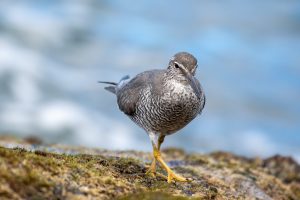ʻŪlili

Names
- ʻŌlelo Hawaiʻi: ‘Ūlili
- Common: Wandering Tattler
- Scientific: Tringa incana, Heteroscelus incanus
Song
Conservation Status
- State recognized as Indigenous
- U.S. Shorebird Conservation Plan—Moderate concern
Species Information

ʻŪlili or Wandering Tattler. PC: Alex Wang
The ‘ūlili, or wandering tattler, remains one of North America’s least known birds. ‘Ūlili winter in the Hawaiian Islands, arriving in stages (adults from July to August, juveniles September to November) and showing strong winter range fidelity. Diet varies with season, and in winter mainly consists of invertebrates such as marine worms, aquatic insects, mollusks, crustaceans, and small fish. On nonbreeding grounds, forages in intertidal habitats (such as coral reefs), less frequently in soft mud or sand, picking food from moist substrates or surface of shallow water. ‘Ūlili also forage along mountain streams, in wetlands, fish ponds, and human-modified areas.
Distribution
‘Ūlili breed mostly in mountainous areas of Alaska, and also in eastern Siberia, but densities are sparse so that precise identification of breeding areas is lacking. Winter range includes most of Oceania from Hawai‘i through more southerly archipelagos. Most abundant in southern and central Pacific. Less common or infrequent in more distant areas of the Pacific. In Hawai‘i, ‘ūlili are more prevalent on shorelines of the NWHI than in the MHI.
Habitat
Wintering habitats throughout the Pacific and mainland Asia are more varied than breeding habitat. ‘Ūlili are common in coastal areas on coral reefs and the basalt platforms of most atolls and islands. They will also make use of soft substrates, especially river mouth areas and littoral margins of lagoons. In the NWHI, they can be found on pickleweed (Sesuvium portulacastrum) flats, and elsewhere in Hawai‘i they will forage in grassy areas around airports and golf courses.
Threats
Primary threats include the following:
- Loss of wetland habitat to development, pollution, or habitat-modifying invasive plants.
- Avian disease.
Plans & Projects
- Kauaʻi Endangered Seabird Recovery Project (KESRP)
- Maui Nui Seabird Recovery Project (MNSRP)
- Lehua Island Ecosystem Restoration Project
- State of Hawaiʻi Biannual Waterbird Surveys
Additional Resources
For more information and references visit the DLNR State Wildlife Action Plan factsheets. DOFAWʻs species pages and State Wildlife Action Plan fact sheets are provided for general information and are not meant to be a citable, original source of data. If you are a student, researcher, or writer looking for a citable source, please explore the references below or find other original data sources, rather than citing these webpages. The references below were provided by the authors of the State Wildlife Action Plan fact sheets at the time of drafting:
- Gill RE, McCaffery BJ, Tomkovich PS. 2002. Wandering tattler (Heteroscelus incanus). In The Birds of North America, No. 642 (Poole A, Gill F, editors). Philadelphia, (PA): The Academy of Natural Sciences; and Washington DC: The American Ornithologists’ Union.
